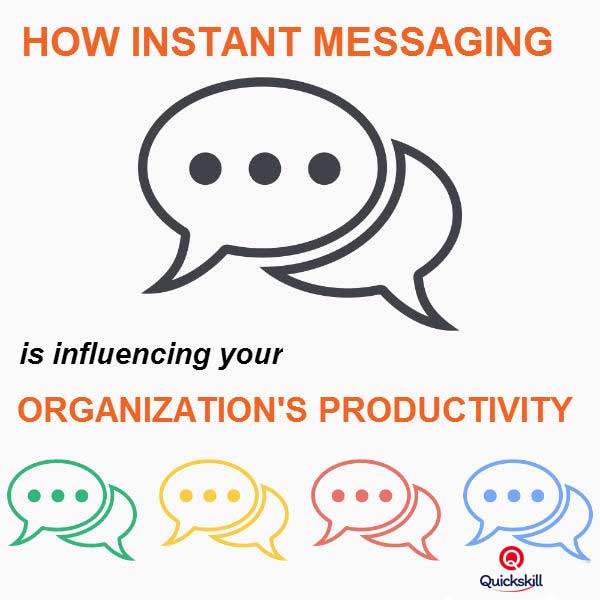How Instant Messaging Is Influencing Your Organization’s Productivity
You’ll enhance your productivity by being deliberate in choosing your communication tools and creating a team-wide policy around those choices. Doing so will also enhance your organization’s productivity and ensure that work does not fall through the cracks.
 One method of communication that is nearly always knee-jerk in practice is instant messaging. Chat windows are quick to open, usually elicit nearly immediate responses and are considered relatively secure. However, they don’t have the permanence or accountability of email, and often go unacknowledged. Here’s how to assess where instant messaging is most suitable in your corporate communications setting.
One method of communication that is nearly always knee-jerk in practice is instant messaging. Chat windows are quick to open, usually elicit nearly immediate responses and are considered relatively secure. However, they don’t have the permanence or accountability of email, and often go unacknowledged. Here’s how to assess where instant messaging is most suitable in your corporate communications setting.
Five strengths of Instant Message or Chat Communication:
- Less interruptive than voice: Online chats are semi-synchronic; meaning you can use them to communicate something “real-time” (as one does by phone), but without being as interruptive. In theory, at least, you can get a message right away without jumping to answer it the way one needs to do when that same message comes by phone. If you finish what you are doing before grabbing the phone, you may miss the call. But that IM message waits for you to complete the task on hand.
- Text can be saved: The message comes written in text, meaning it can be copied and pasted, and as in the case of GChat, searched and archived.
- Unobtrusive for neighbors: Chatting is quiet, meaning you can have a conversation without the noise disturbing your officemates or others on a train, on a plane, or in a doctor’s waiting room. Conversations in chat windows can also be used to get clarification around something after a meeting, thus avoiding taking up others’ time where it’s not necessary.
- Private: This quietness, and near real-time nature also makes chats perfect for private communication. It is often used to build relationships with the people you work with – whether to provide a shorthand way to check in or whether it serves as a virtual office water cooler. .
- Multiparty: Multi-party ability allows for a quiet conference call through chat windows, though many would challenge that this is a strength.
Five Weaknesses in Instant Message Communication:
- No good record: Detailed information communicated in chat is hard to find later, as even platforms that include historical logging of past conversations are not easily searchable or locatable. That means that there is no real record or referral point for action items or tasks being assigned within an instant message.
- Highly distracting: If you can’t resist toggling over to your chat program the instant it blinks, it may be just as intrusive as a phone call. In fact, this is often the main reason that someone chooses to use this form of communication. It’s the functional equivalent of tapping someone on the shoulder or walking into their office to ask a question.
- Less organized and structured: Thoughts relayed on IM tend to be in the vernacular, meaning they are not as logically structured as they might be by email. In multi-party conversations, unlike in a live meeting where someone is taking notes, people can talk or throw out ideas without taking responsibility for them. Unless each user is meticulous about pinpointing who they’re speaking to and responding to each chat message that identifies them, it is nearly impossible to parse through the discussion to identify action items.
- Encourages time-wasting, frivolous communication: Even important messages tend to be sandwiched between frivolous salutations and even gossip. This may keep you plugged in to key office politics and help team bonding, but it will also consume valuable time.
- Lacks audio and visual cues: People sometimes think they can use instant messages for long conversations that should be had by phone. The time lapses between responses and the lost visual and audio cues helpful in other real-time conversation can create serious misunderstandings.
Example IM policy
Here are a set of five policies that optimize your organization’s use of instant messages and help avoid its weaknesses.
- Avoid using for complex points: Use IM to relay quick points or brief clarifications, and not to relay complex ideas that ought to be structured in an email or document.
- Never assign tasks via IM: Tasks should be easily recallable and tracked, and IM does not facilitate this well. It lacks both the permanence and accountability of email.
- Don’t chatter below your aspiring pay grade: Walk the fine line of participating in just enough chatter with colleagues to maintain a good bond and to stay informed, but don’t become the person who fuels a gossip culture.
- Give the benefit of the doubt: This is a good rule for any office communication, but especially for IM discussions. Never assume any subtext behind delayed responses or other issues that might be easily clarified through visual and verbal cues available with in-person or video communication. Be direct in your communication to avoid confusion and make sure colleagues know that your direct style is not an indication of coldness or disregard for politeness.
- Keep control of your time: Have an explicit mental understanding of when you go to look at a message. Be sure you wait for good break points in your work.

